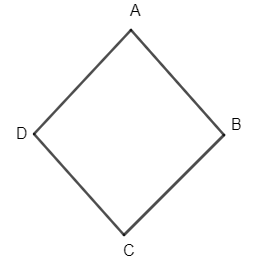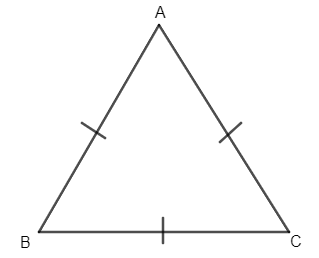
All sides of a regular polygon are
(a) Equal in length
(b) Parallel
(c) Not parallel
(d) Not equal
Answer
554.7k+ views
Hint: We are asked about the sides of a regular polygon, we will first learn about the polygon and work with some examples of a polygon. Then we will learn about “regular”. Once we learn this we will study what a regular polygon is like and when we do this much, we will reach our answer.
Complete step by step answer:
We are asked that what can be said about the sides of a regular polygon. To answer this, we will first learn certain things. First of all, we will understand the definition of a polygon. A polygon is a closed geometric figure with at least 3 straight sides and an angle. If they have 3 sides, we call them triangles.
If the sides of a polygon are 4, then we call them a quadrilateral.

If the sides of the polygon are 5, then they are known as a pentagon.

Now, we will learn about the word ‘regular’. The word regular is used to provide a constant thing. So, now we will learn about regular polygon. A regular polygon is a closed figure (geometry) with at least 3 sides and angles is called a regular polygon if all the angles and all the sides are equal. For example, the equilateral triangle is an example of a regular polygon with 3 sides because all its angles and sides are equal.

Square is an example of a regular polygon with 4 sides as all the sides of the square are equal in length and all the angles are also equal.
Similarly, for other numbers of sides, if any closed figure which has all the sides and angles are of equal measure, then they are considered as a regular polygon. So, we get, in a regular polygon, all the sides are of equal length.
Hence, option (a) is the right answer.
Note:
We can also cross-check other options.
Option (b) all the sides are parallel: If all the sides are parallel, it can’t make a closed figure, hence can’t be a polygon.
Option (c) all the sides are not parallel: In some polygons like squares, the opposite sides are parallel, so this statement is also incorrect.
Option (d) all sides are not equal: If all the sides are not equal, then it will violate the definition of a regular polygon. Hence this option is also incorrect.
Complete step by step answer:
We are asked that what can be said about the sides of a regular polygon. To answer this, we will first learn certain things. First of all, we will understand the definition of a polygon. A polygon is a closed geometric figure with at least 3 straight sides and an angle. If they have 3 sides, we call them triangles.
If the sides of a polygon are 4, then we call them a quadrilateral.

If the sides of the polygon are 5, then they are known as a pentagon.

Now, we will learn about the word ‘regular’. The word regular is used to provide a constant thing. So, now we will learn about regular polygon. A regular polygon is a closed figure (geometry) with at least 3 sides and angles is called a regular polygon if all the angles and all the sides are equal. For example, the equilateral triangle is an example of a regular polygon with 3 sides because all its angles and sides are equal.

Square is an example of a regular polygon with 4 sides as all the sides of the square are equal in length and all the angles are also equal.
Similarly, for other numbers of sides, if any closed figure which has all the sides and angles are of equal measure, then they are considered as a regular polygon. So, we get, in a regular polygon, all the sides are of equal length.
Hence, option (a) is the right answer.
Note:
We can also cross-check other options.
Option (b) all the sides are parallel: If all the sides are parallel, it can’t make a closed figure, hence can’t be a polygon.
Option (c) all the sides are not parallel: In some polygons like squares, the opposite sides are parallel, so this statement is also incorrect.
Option (d) all sides are not equal: If all the sides are not equal, then it will violate the definition of a regular polygon. Hence this option is also incorrect.
Recently Updated Pages
Two men on either side of the cliff 90m height observe class 10 maths CBSE

What happens to glucose which enters nephron along class 10 biology CBSE

Cutting of the Chinese melon means A The business and class 10 social science CBSE

Write a dialogue with at least ten utterances between class 10 english CBSE

Show an aquatic food chain using the following organisms class 10 biology CBSE

A circle is inscribed in an equilateral triangle and class 10 maths CBSE

Trending doubts
Why is there a time difference of about 5 hours between class 10 social science CBSE

Write a letter to the principal requesting him to grant class 10 english CBSE

What is the median of the first 10 natural numbers class 10 maths CBSE

The Equation xxx + 2 is Satisfied when x is Equal to Class 10 Maths

Which of the following does not have a fundamental class 10 physics CBSE

State and prove converse of BPT Basic Proportionality class 10 maths CBSE




